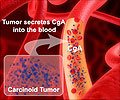
The doctors and their stage III or stage IV cancer patients volunteered to be recorded during routine visits. Researchers then analyzed the 49 audio-recorded encounters that took place between November 2011 and June 2012, and looked for key observable markers of compassion.
In contrast to empathy - another quality that Epstein and his colleagues have studied in the medical community-compassion involves a deeper and more active imagination of the patient's condition.
An important part of this study, therefore, was to identify examples of the three main elements of compassion: recognition of suffering, emotional resonance, and movement towards addressing suffering.
Emotional resonance, or a sense of sharing and connection, was illustrated by this dialogue: Patient: "I should just get a room here." Oncologist: "Oh, I hope you don't really feel like you're spending that much time here."
Researchers evaluated tone of voice, animation that conveyed tenderness and understanding, and other ways in which doctors gave reassurances or psychology comfort.
Advertisement
Source-ANI










